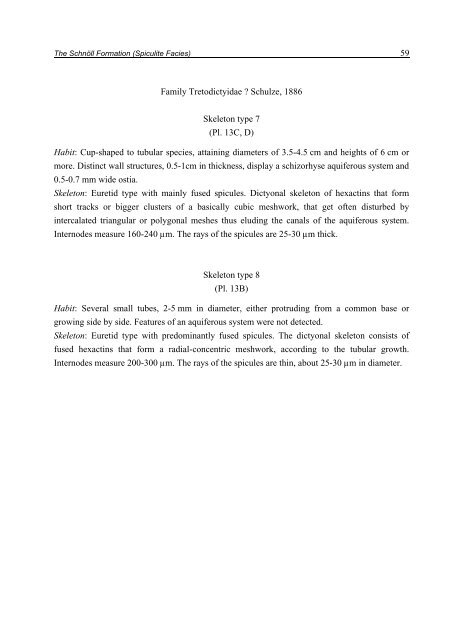Porifera-microbialites of the Lower Liassic (Northern Calcareous ...
Porifera-microbialites of the Lower Liassic (Northern Calcareous ...
Porifera-microbialites of the Lower Liassic (Northern Calcareous ...
Create successful ePaper yourself
Turn your PDF publications into a flip-book with our unique Google optimized e-Paper software.
The Schnöll Formation (Spiculite Facies) 59<br />
Family Tretodictyidae ? Schulze, 1886<br />
Skeleton type 7<br />
(Pl. 13C, D)<br />
Habit: Cup-shaped to tubular species, attaining diameters <strong>of</strong> 3.5-4.5 cm and heights <strong>of</strong> 6 cm or<br />
more. Distinct wall structures, 0.5-1cm in thickness, display a schizorhyse aquiferous system and<br />
0.5-0.7 mm wide ostia.<br />
Skeleton: Euretid type with mainly fused spicules. Dictyonal skeleton <strong>of</strong> hexactins that form<br />
short tracks or bigger clusters <strong>of</strong> a basically cubic meshwork, that get <strong>of</strong>ten disturbed by<br />
intercalated triangular or polygonal meshes thus eluding <strong>the</strong> canals <strong>of</strong> <strong>the</strong> aquiferous system.<br />
Internodes measure 160-240 µm. The rays <strong>of</strong> <strong>the</strong> spicules are 25-30 µm thick.<br />
Skeleton type 8<br />
(Pl. 13B)<br />
Habit: Several small tubes, 2-5 mm in diameter, ei<strong>the</strong>r protruding from a common base or<br />
growing side by side. Features <strong>of</strong> an aquiferous system were not detected.<br />
Skeleton: Euretid type with predominantly fused spicules. The dictyonal skeleton consists <strong>of</strong><br />
fused hexactins that form a radial-concentric meshwork, according to <strong>the</strong> tubular growth.<br />
Internodes measure 200-300 µm. The rays <strong>of</strong> <strong>the</strong> spicules are thin, about 25-30 µm in diameter.

















